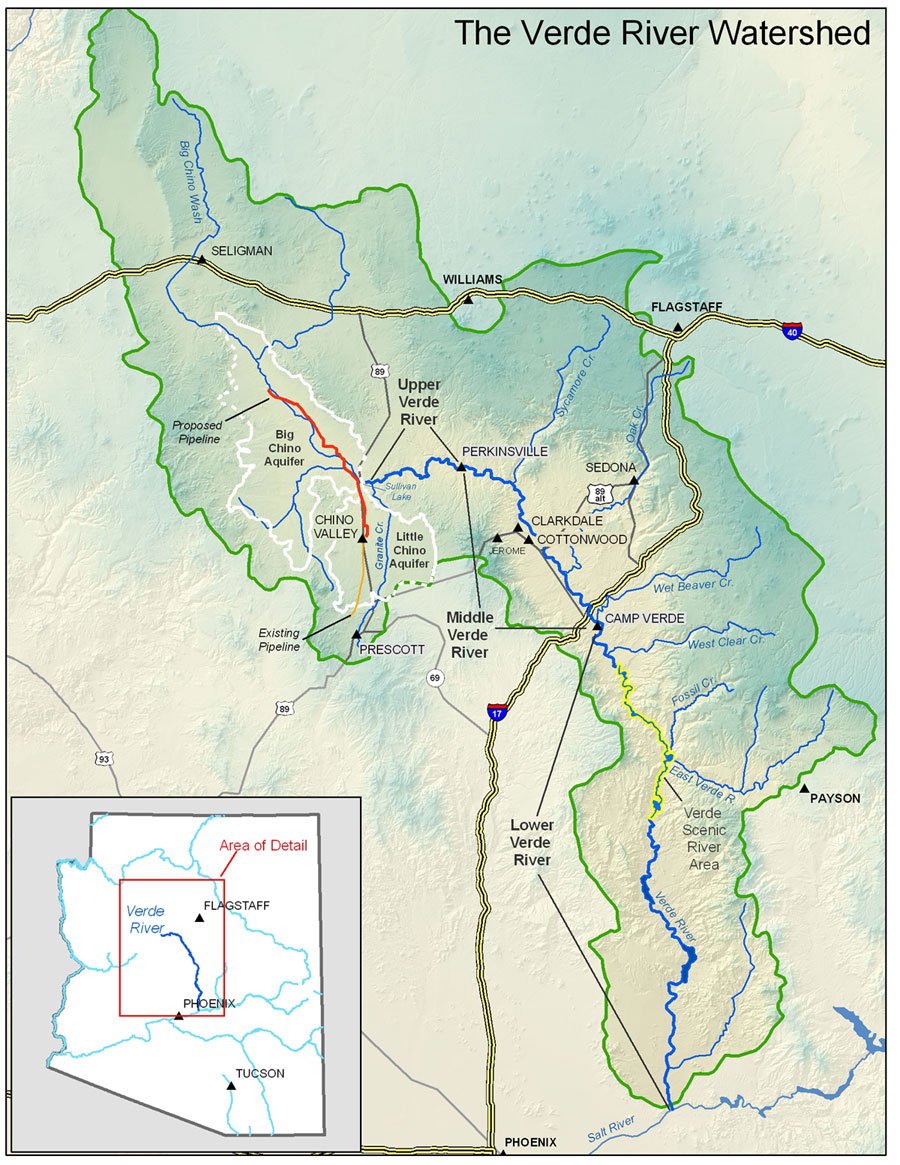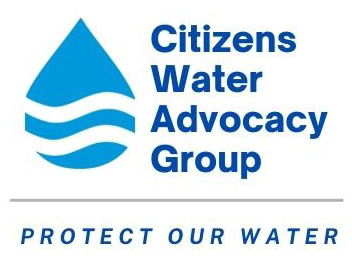CWAG's official position on the BCWR is available here. Basic hydrology concepts require that to mitigate the effects of groundwater mining, an equal volume of mitigation water must be restored to the aquifer. To date no scientific mitigation plan has been published and no alternative water sources have been identified. Historically irrigated acres (HIA) are agricultural lands irrigated between January 1, 1975 and January 1, 1990. ADWR reported 3,582 acres of HIA lands in the Big Chino. State law permits exporting 3 afy for each acre of HIA lands that are permanently retired from irrigation, therefore up to approximately 10,746 afy of HIA Groundwater can be legally exported to the PrAMA for municipal uses. Very large scale rainwater harvesting projects could contribute to mitigation using BCWR land that has been retired from agricultural irrigation. For example: the BCWR partners would need to prepare 1256 acres of retired farmland by removing vegetation, contouring, coating, fencing, and installing a network of collection pipes; at 12" annual rainfall and 50% collection efficiency, the project could collect about 600 afy on average (based on examples in Australia). The Upper Verde River Watershed Coalition is attempting to develop pilot projects to clear cut 340,000 acres of pinyon-juniper in the Big Chino Valley. The Coalition claims that cutting trees will make the forest healthy and improve the watershed, creating economic development, and increasing recharge. This Op-Ed shows that clearing trees in arid areas will not increase recharge.
Mitigation Agreement
 As part of an agreement with SRP, Prescott and Prescott Valley promised to mitigate the portion of base flow diminishment caused by their proposed Big Chino Water Ranch (BCWR) pumping. Here, "mitigation" refers to unspecified actions that would counteract the decline in base flow caused by transferring groundwater out of the Big Chino basin.
As part of an agreement with SRP, Prescott and Prescott Valley promised to mitigate the portion of base flow diminishment caused by their proposed Big Chino Water Ranch (BCWR) pumping. Here, "mitigation" refers to unspecified actions that would counteract the decline in base flow caused by transferring groundwater out of the Big Chino basin.
Updated December 19, 2018
CWAG Position on Big Chino Water Ranch
To maintain the health of the Verde River and the riparian habitat, CWAG defines mitigation as: 1) No diminution in base flow from project pumping; 2) No degradation in water quality; and 3) Preservation of historical flood flows. These conditions will assure that the upper Verde River will remain a living river, and that domestic wells in the Paulden community will not be harmed. CWAG insists that the BCWR project must be fully mitigated to prevent the upper Verde River from eventually suffering a debilitating loss of base flow.
The financing for the BCWR must be approved by the voters in Prescott (Prop 401). CWAG insists that a practical, scientifically valid, and fully funded mitigation plan must be in place in advance of the 401 election.
A realistic, fully funded mitigation plan - in advance of construction - is essential. Unless an acceptable mitigation plan is developed, national environmental organizations will litigate; these lawsuits could drag on for years at taxpayer expense.
Any plan to reach safe yield in the PrAMA must not put other areas into overdraft or contribute to the destruction of important natural resources such as Del Rio Springs and the upper Verde River. Therefore, all water exported from the Big Chino must be mitigated.
Updated December 19, 2018
Is Mitigation Possible?
Some possible mitigation methods include HIA water, large scale rainwater harvesting, effluent recharge, and vegetation management. All of these possible mitigation methods have substantial problems, as discussed in the sections below.
At this time, CWAG can not identify adequate mitigation resources. The only possibly effective mitigation would be to retire actively pumping agricultural wells, a partial solution at best.
Updated December 19, 2018
Mitigation Using HIA Water
Dedicating all of the approximately 3,768 afy of HIA water from the BCWR to mitigation - foregoing importation - could be a partial solution. However, ADWR has not officially quantified HIA water resources. HIA water quantity is based on state law authorizing 3 af/acre, not on actual measurements of agricultural net water use; this does not agree with USGS estimates of Big Chino agricultural water use of 2 af/acre. Also, it is not known if HIA mitigation will meet CWAG’s requirement to not diminish base flow.
HIA water will not be available for municipal and industrial use unless Prescott decides to release some HIA water as "Additional Water." If "Additional Water" becomes available, the City of Prescott has commited its share of HIA water (perhaps about 2,000 afy) to mitigation or safe yield - not to growth - but Prescott Valley has made no committment to its use of HIA water.
In summary, in the best case, 3,768 afy of HIA water is inadequate to mitigate 8,068 afy of groundwater removal.
Updated December 19, 2018
Mitigation using Landscape Scale Rainwater Harvesting
The problems are enormous environmental damage, extremely high costs, and challenging legal issues.
Updated December 19, 2018
Mitigation Using Effluent Recharge
 Prescott and Prescott Valley now collect wastewater from their municipal sewer system, treat it to A+ water quality, then recharge the effluent in the Little Chino Valley.
Prescott and Prescott Valley now collect wastewater from their municipal sewer system, treat it to A+ water quality, then recharge the effluent in the Little Chino Valley.
Effluent recharged in the Little Chino cannot prevent loss of base flow caused by pumping in the Big Chino.
The recharged water needs a century to flow to the Chino Valley well field. Decades of overdraft pumping in Chino Valley has created a large “cone of depression,” similar to a hole in the aquifer, that will “trap” the recharge before it reaches the Verde, plus the recharge volume is much less that the pumping.
Effective recharge for mitigation would require an effluent pipeline to be constructed from the Prescott area to Paulden for recharge above the headwaters. Again, the mitigation water quality must be A+ to protect native fish listed by the Endangered Species Act.
More importantly, sufficient effluent is not available. Prescott is required by Proposition 400 to dedicate all effluent from new subdivisions – the intended receiver of the Big Chino water – to safe yield so that effluent would not be available for mitigation. Prescott’s existing effluent is now fully committed to short-term recharge credits and to long-term direct reuse for golf course irrigation. Prescott Valley has sold its effluent credits to investors to supply water credits for new subdivisions. Chino Valley has a small recharge facility.
One possible source of treated effluent would be to connect all of Chino Valley and Paulden to sewer systems to collect effluent for recharge. The expense is huge and the amount of effluent collected is inadequate.
Updated December 19, 2018
Mitigation Using Vegetation Management
Updated December 19, 2018
Mitigation
The BCWR partners believe that an advanced groundwater model - a “nested” model using higher temporal and spatial resolution near the BCWR but surrounded by the NARGFM model - could identify the timing, recharge location, and quantity of mitigation water needed. The partners have now retained a hydrological consultant to develop the nested model, but they have neither released a specific mitigation plan nor any cost information. The City of Prescott states that the modeling may be complete by 2022.
Professional hydrologists agree with CWAG that basic hydrology principles clearly indicate that groundwater pumping in the Big Chino Valley will diminish the base flow of the Verde River by an amount equal to the pumping.
